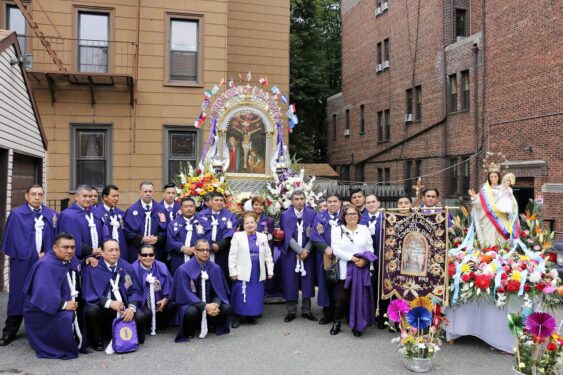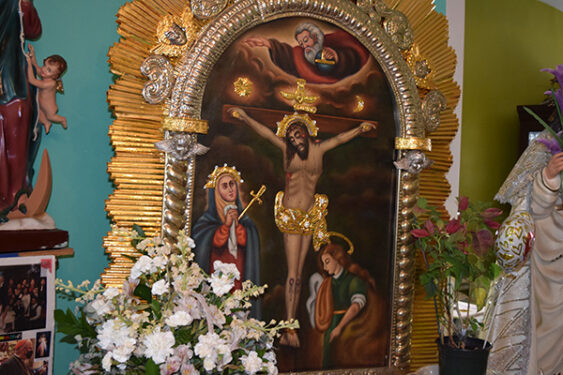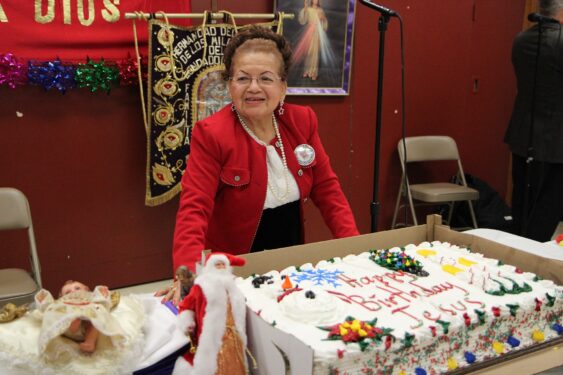
WOODSIDE — Olga Gonzalez still recalls the day in 1970 when Bertha Newman walked into Cofri, the travel agency she owned on Roosevelt Avenue, and talked to her about starting a religious procession to pay tribute to the Lord of Miracles — a Peruvian religious tradition.
Newman was diminutive, standing only 4-feet-11, but she had a powerful presence packed into her small frame and was very persuasive, Gonzalez recalled. “She was looking for people to help her,” Gonzalez said through a translator.
Gonzalez ultimately agreed to assist her fellow Peruvian immigrant in starting a Lord of Miracles tradition in New York City. Within a few years, Newman and a small group of organizers founded the Hermandad del Señor de los Milagros — or Brotherhood of the Lord of Miracles.
The brotherhood organizes the annual Lord of Miracles procession in Queens in which men carry a giant replica of a famous image of Jesus Christ on the cross painted in Lima, Peru in the 17th century by a slave from Angola. Pilgrims visit Lima from all over the world to venerate the Lord of Miracles painting, and the artwork is believed to be responsible for numerous miracles over the centuries.
Newman died on July 3 at age 88, but her five daughters are determined to carry on her tradition by staging the procession every October. In recent years, St. Sebastian Church has been the starting point for the procession, which winds its way through the streets.
“The greatest thing my mother taught me was a sense of responsibility. She felt responsible for the procession, so we’re going to continue her work,” said Carmen Bissell.
Bissell and two of her sisters, Rebecca Newman-Mahoney and Mina Newman-Estudillo, met with the Tablet at Newman’s Woodside home to talk about their mother and the Lord of Miracles tradition she started in the Diocese of Brooklyn.

Newman’s daughters said they were inspired by their mother’s deep devotion and willingness to work hard to make sure the procession was done right.
“She was an event planner for Jesus,” Bissell said.
To walk into Newman’s home is to see first-hand her deep devotion to the Lord of Miracles. As soon as one enters the living room, one is struck by the sight of a large framed replica of the painting sitting on a pedestal in a corner of the room. Prayer books and candles line the tables.
The room doesn’t have furniture, but that’s because of Newman’s generosity. “The reason you see no furniture in this room is because my mother gave it away,” said Newman-Mahoney, explaining that a musician who plays in the procession every year lost all of his belongings in a house fire. Newman gave the man her living room set.
Born Bertha Limo in Chiclayo, Peru in 1932, she came to the U.S. in 1965 and settled in Queens. She met and married William Newman and the couple had five daughters — Denise, Carmen, Frances, Mina, and Rebecca. William Newman was so inspired by his wife’s deep religious devotion that he converted from Judaism to Catholicism. He died a few years ago, his daughters said.
Having grown up with the Lord of Miracles tradition in Peru, Newman was surprised to learn that there were no processions for it here in the U.S. She decided to do something about it.
“She started to ask around. ‘Where can we have a Mass? Where can we have a procession?’ She was so devoted to the Señor de los Milagros that she wanted to start it here. This, in Peru, is huge. The entire city of Lima shuts down,” Newman-Mahoney said.
The first Masses and procession organized by Newman took place in 1974 in St. Benito Church in Manhattan. Within a few years, through Newman’s perseverance, the traditional Mass took place at St. Patrick’s Cathedral with a procession up Fifth Avenue. It eventually spread to parts of the city, including Queens, where Newman lived.

Today, the Señor de los Milagros Masses and processions draw thousands of people from across the tri-state area.
“It was not here until her. She was the first person in the United States to have a Señor de los Milagros,” Gonzalez said.
For the Newmans, the Señor de los Milagros events were a family affair. All of Newman’s daughters helped their mom plan the procession — doing everything from having fliers printed up to acquiring city permits.
“My mother inspired me by setting an example. But also with a little bit of a push. She told us, ‘This is what we do.’ She set a standard for us,” Mina Newman-Estudillo.
In addition to bringing a piece of Peru to the U.S., Newman’s goal in starting the Señor de los Milagros was to have it serve as an evangelization tool. There are many people who were not religious but who joined the Catholic Church after taking part in the procession, the women explained.
“She also did religious retreats,” Newman-Mahoney said. “She was always working to bring people closer to Jesus.”
